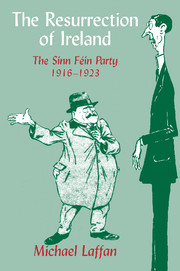Book contents
- Frontmatter
- Contents
- List of illustrations
- List of figures and tables
- Preface
- Note on the text
- List of abbreviations
- PROLOGUE: BEFORE THE EASTER RISING
- THE IRISH REVOLUTION, 1916–1923
- 2 Rebellion and hibernation, 1916
- 3 Organizers and converts, 1917
- 4 Reverses and victory, 1918
- 5 The party: structures and members
- 6 Policy: beliefs and attitudes
- 7 War and repression, 1919–1921
- 8 Ministers and bureaucrats, 1919–1921
- 9 The treaty and the split, 1921–1922
- 10 The Pact election and the Civil War, 1922–1923
- EPILOGUE: AFTER THE CIVIL WAR
- Select bibliography
- Index
2 - Rebellion and hibernation, 1916
Published online by Cambridge University Press: 05 March 2012
- Frontmatter
- Contents
- List of illustrations
- List of figures and tables
- Preface
- Note on the text
- List of abbreviations
- PROLOGUE: BEFORE THE EASTER RISING
- THE IRISH REVOLUTION, 1916–1923
- 2 Rebellion and hibernation, 1916
- 3 Organizers and converts, 1917
- 4 Reverses and victory, 1918
- 5 The party: structures and members
- 6 Policy: beliefs and attitudes
- 7 War and repression, 1919–1921
- 8 Ministers and bureaucrats, 1919–1921
- 9 The treaty and the split, 1921–1922
- 10 The Pact election and the Civil War, 1922–1923
- EPILOGUE: AFTER THE CIVIL WAR
- Select bibliography
- Index
Summary
The Easter Rising revived the use of political violence and transferred it from the margins to the centre of Irish nationalism. It restored continuity with past insurrections, it maintained and enhanced the revolutionary tradition, and it provided a model for later generations of Irish republicans who would take arms to achieve their objectives. In all these ways it fulfilled the hopes of the rebel leaders. Its immediate effect was to transform Irish public life, and it did so in ways which were often unexpected and sometimes paradoxical.
Insurrection
The rebellion was a Dublin affair. A few incidents took place outside the capital: a skirmish in Galway, shooting incidents in Cork and Wexford, and a guerrilla campaign in Meath and north Co. Dublin which foreshadowed the war of 1919–21. But with these exceptions the rising was confined to the capital. The separatist newspaper The Spark had recently prophesied a Volunteer revolt during 1916 which would involve a landing by the Germans, the liberation of most of Ireland, and Dublin remaining in British hands. It was wrong in every detail. (Curiously H. G. Wells's recent novel The new Machiavelli anticipated indirectly one aspect of the Easter Rising; its hero imagined a revolutionary provisional government in London ‘which occupied, of all inconvenient places! the General Post Office at St. Martin's le Grand’.
- Type
- Chapter
- Information
- The Resurrection of IrelandThe Sinn Féin Party, 1916–1923, pp. 43 - 76Publisher: Cambridge University PressPrint publication year: 1999



